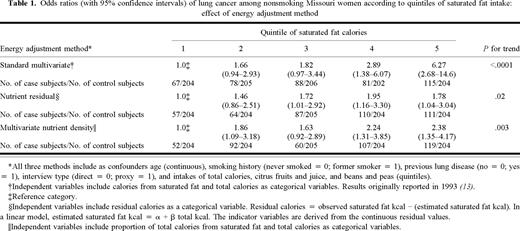Mendelian Randomization Reveals the Dietary Fat-Lung Adenocarcinoma Connection: Insights from GWAS Data
Mendelian Randomization Reveals the Dietary Fat-Lung Adenocarcinoma Connection: Insights from GWAS Data
Background: Lung cancer has a high mortality rate and lung adenocarcinoma (LUAD) is one of the most common types of lung cancer. A high-fat diet had been reported to be connected with the development of the LUAD. Thus, this study aimed to investigate the causal relationship be...
Abstract
Background: Lung cancer has a high mortality rate and lung adenocarcinoma (LUAD) is one of the most common types of lung cancer. A high-fat diet had been reported to be connected with the development of the LUAD. Thus, this study aimed to investigate the causal relationship between a high-fat diet and LUAD using Mendelian randomization (MR) analysis.
Methods: The study conducted MR analysis by using critically ill patients with the LUAD (n=18336, single nucleotide polymorphism (SNP)=8,881,354). Ratio of linoleic acid (LA) to total fatty acids (n=114,999, SNP=12,321,875), total cholesterol (n=115,078, SNP=12,321,875), and ratio of saturated fatty acids (SFA) to total fatty acids (n=114,999, SNP=12,321,875) summary statistics were obtained from the Open Genome Wide Association Study (GWAS) database. Exposure factor reading and instrumental variable (IVs) screening were performed by the TwoSampleMR function extract_instruments, and independent SNPs with p < 5×10-8 were selected as IVs. Notably, SNPs with linkage disequilibrium (LDA) were excluded by performing an aggregation procedure with r2=0.001 and kb=10,000 kb. The study combined different algorithms (Weighted median, Simple mode, Inverse variance weighted, MR Egger, Weighted mod) to perform MR analysis, and the results were mainly referred to Inverse variance weighted (IVW).
Results: Univariate MR analysis showed that both ratio of SFA to total fatty acids as well as total cholesterol were consequently connected with the development of LUAD and were risk factors (p<0.05, odd ratio (OR)>1). Ratio of LA to total fatty acids was consequently connected with the occurrence of LUAD and was a protection factor (p<0.05, OR<1). Moreover, multivariate MR analysis showed that total cholesterol was a significant risk factor (p<0.05). The ratio of SFA to total fatty acids was a risk factor and ratio of LA to total fatty acids was a safety factor.
Conclusion: Total cholesterol, ratio of saturated fatty acids to total fatty acids, and ratio of linoleic acid to total fatty acids were causally connected to the LUAD.


